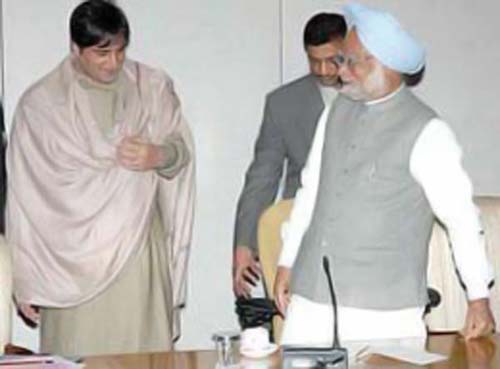
“This is a kind of blind trade and under such circumstances most of the products remain under-valued due to lack of knowledge of the markets,” said a cross LoC trader.
The trader maintained that there is nothing left in this trade. “If we stop, both countries will blame us for not co-operating. But when we demand facilities, they are showing cold response,” he said.
The cross LoC trade was several times stopped by traders in protest against the attitude of both sides alleging that both the governments are not serious enough in providing the adequate facilities and they are facing losses by continuing the trade this way.
Despite tax exemption to LoC traders, the absence of banking facilities, infrastructure problems and barter system of trade continues to trouble the traders.
On September 5, 2005, Dr Manmohan Singh met Hurriyat moderates led by Mirwaiz Umar Farooq. Both sides agreed “to ensure that all forms of violence at all levels should come to an end” and an “honourable and durable solution should be found.”
Dr Singh assured that he is committed to provide “a life of peace, self respect and dignity” to the people of J&K and would review the cases of those detained. In an atmosphere of criticism and lack of concrete results, this meeting was important for many reasons. It provided a major impetus to the peace process with Pakistan and strengthened New Delhi’s efforts to reconcile internally with the Kashmiris.
For the first time after the outbreak of rebellion, New Delhi seemed to be taking bold steps towards Kashmir, abandoning its adhoc approaches.
If opening of the LoC was a bold step, allowing intra-Kashmiri interaction on a regular basis was a bolder move.
The Union government’s engagement with Hurriyat in particular had been uniform in the later months. The Congress persisted with the services of N N Vohra, Wajahat Habibullah and A S Dullat to reach the Hurriyat leadership. All these important people were believed to be important links in the round of negotiations between the moderate separatists and Manmohan Singh.
The moderates had two rounds of high-level discussions with L K Advani earlier. Having encouraged Track-II level contacts between the moderate Hurriyat leadership and its interlocutors, the Congress government allowed them to visit Pakistan Administered Kashmir (PaK).
“The moderate separatist leaders had been requesting the Indian government for many years then to allow them to visit Pakistan, to include Islamabad in the dialogue and make it a trilateral process,” a top congress leader told Kashmir Life. He added that the Union government permitted the leaders to visit other countries as well.
On February 17, 2006 Prime Minister Manmohan Singh met separatist leader and chief of the Jammu and Kashmir Liberation Front (JKLF), Mohammad Yasin Malik, in New Delhi and reportedly assured him that the Union Government has an “open mind” and would like to involve a larger section of public opinion to end “the period of suffering”.
“In his first meeting with Malik, Dr. Singh said there was an air of optimism in Jammu and Kashmir and an opportunity to bring lasting and permanent peace in the State,” reported Press Trust of India (PTI).
Malik was the second separatist after Sajjad Gani Lone of the People’s Conference who was invited by the Prime Minister for talks on the Kashmir issue.
On January 15, 2006 Prime Minister Manmohan Singh met Sajjad Lone “to bring more disgruntled Kashmiris within the ambit of talks.”
Emerging after a two-hour meeting, Lone had said the PM assured him that this process of dialogue with more people would go on. Lone was reportedly asked to produce some concrete and written formula to solve the Kashmir tangle inspiring him to pen down “The Achievable Nationhood”.
Lone met the prime minister in presence of the then National Security Advisor, M K Narayanan, then home secretary V K Duggal, and then Centre’s point man on Kashmir, N N Vohra.
After the Amarnath land row, during which around sixty civilians lost their lives including a frontline separatist leader, Sheikh Abdul Aziz, the killing of mostly innocent students during 2010 uprising shook the conscience of Indian civil society members.















